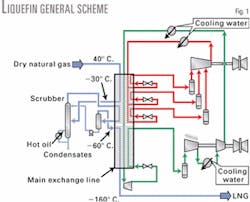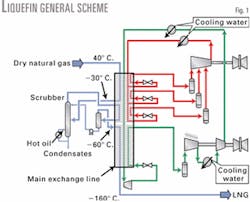New liquefaction process promises lower costs
Yet another LNG liquefaction process has recently become commercially available and claims to cut the cost of LNG production by 20%.
Liquefin, commercialized by IFP-Axens, France, was developed in cooperation with a major oil and gas company, says the company, with benefits recently demonstrated in studies conducted by engineering contractors and vendors for the main compression and the main exchange lines.
MR basis
In the process (Fig. 1), the prerefrigeration of the gas is achieved by use of a mixed refrigerant instead of propane. The prerefrigeration cycle operates at a much lower temperature than in a conventional dual-cycle process: The temperature is decreased to a range of from -50° to -80° C. (-60° to -110° F.).
At these temperatures, says Axens, the cryogenic mixed refrigerant can completely condense. No phase separation is necessary, and the quantity of cryogenic refrigerant is substantially reduced.
The molar ratio between the cryogenic mixed refrigerant and LNG can be, in some cases, lower than 1.
Overall required power is decreased because much of the energy necessary to condense the mixed refrigerant is shifted from the cryogenic cycle to the prerefrigeration cycle. This leads to a better distribution of the required heat-exchange area, says the company: The same number of cores in parallel can be used between the ambient and cryogenic exchange sections.
In the Liquefin process, both mixed refrigerants are used in the same way as pure components. The mixed refrigerant is condensed and vaporized at different pressure levels in each section, without any phase separation or fractionation. This way, the exchange line can be very simple and compact, says Axens.
A significant advantage of this new scheme, says the company, is the ability to adjust the power balance between the two cycles. It is thus possible to use the full power provided by two identical gas turbines with no transfer of power from one cycle to the other.
Axens also claims the process has the positive features of the cascade process with a much better efficiency and fewer pieces of rotating equipment. Advantages, according to the company, include:
- No integrated cascade. As the mixed refrigerant of the second cycle is fully condensed, the two mixed refrigerants can be used similarly to how pure refrigerants are used in the cascade process.
- Balanced power. The process is easily adjustable to obtain the same power for each cycle. With two identical gas turbines, it avoids the difficulty, encountered with the C3-mixed refrigerant (C3-MR) cycle, of having to transmit power somehow from the precooling gas turbine to the cryogenic cycle.
- Compact heat-exchange line. The Liquefin process has also been defined to make the best use of plate-fin heat exchangers (PFHEs). A single heat-exchange line is used to cool gas from ambient temperature to cryogenic temperatures. The process has been conceived to make the exchange line simple and compact.
Cold-box design
The PFHE arrangement is at the heart of the liquefaction technology, says Axens. Aluminum offers negligible resistance to heat transfer between fluids, according to the company; moreover, the extended surface provided by the fins leads to high heat-transfer efficiency, enabling a good exchange and a low-temperature differential. A high surface density of up to 2,000 sq m/cu m is attainable, which Axens says is important in the reduction of footprint, weight, and therefore cost.
Unlike shell-and-tube exchangers, in which a single stream can be used on the shell side, PFHEs may simultaneously handle warm and cold streams at various pressures.
The Liquefin process is especially adapted to the use of PFHEs: All fluids entering the main exchange line, except the outlets of the Joule-Thomson valves, are in a single phase-vapor or subcooled liquid. Moreover, a special arrangement at the outlet of the Joule-Thomson valves ensures the right amount of refrigerant in each parallel core and even distribution between the different channels of a core, says the company. Even distribution is one of the key parameters to ensure full efficiency of the process.
For a capacity about 4.5 million tonnes/year, the total precooling and liquefaction heat exchange are deployed in four cold boxes, each with six parallel lines consisting of two PFHE cores in series. The total heat exchange of a large train is thus gathered in a 250 sq m (2,750 sq ft) area, with a height no more than 15 m (50 ft).
Comparison
The exchange line is the main novelty of this process, says Axens. In addition to PFHE manufacturers' extensive experience of similar equipment, Axens carried out advanced research and development studies on PFHEs related to thermal efficiency, fluid dynamics, and mechanical behavior.
Sophisticated stress analyses on all parts of the cryogenic assembly have been performed in close co-operation with PFHE manufacturers, says Axens.
A thorough comparison has been done with the C3-MR process, trying to compare "like for like": same gas turbines, same helpers, same process approach for air-coolers, etc. When compared with the conventional C3-MR process, says Axens, Liquefin offers a higher capacity due to several combined process and equipment factors:
- Use of mixed refrigerant instead of propane for prerefrigeration affords a closer approach of the heating-cooling enthalpy curves than with a pure component in the prerefrigeration section.
- Use of a PFHE combined with this special process allows a very close fit of the warming and cooling enthalpy curves all along the liquefaction section, thus improving the thermodynamic efficiency. In the C3-MR case, even if the mixed refrigerant is optimized to reduce the pinch, the maximum size of the spiral wound exchanger forbids such a low log-mean temperature difference for the high train capacities.
- Use of mixed refrigerant instead of propane for prerefrigeration enables a reduction of the break point between the prerefrigeration section and the liquefaction section down to -60° to -80° C., depending on feed composition, from -30° C. Thus, the cryogenic mixed refrigerant is completely liquefied in the prerefrigeration section, resulting in a lower power requirement.
- Air-cooler size is lower for the same approach with a mixed refrigerant compared to a pure component (or, stated differently, a higher capacity is possible with the same air-cooler size).
- Low pressure-drop on both sides of a PFHE gives an efficiency advantage to the Liquefin process, says Axens. The high pressure-drop on the tube side of a spiral wound exchanger leads to an efficiency loss by decreasing natural gas liquefaction pressure and by decreasing the mixed-refrigerant pressure at the liquid turbine inlet.
Investment cost
Several engineering contractors performed detailed cost estimates of the liquefaction plant, within the framework of frontend engineering designs (FEEDs) and pre-FEEDs currently performed with majors and national oil and gas companies, says Axens. Their results show a 20% overall reduction in cost-per-tonne of LNG.
Cost savings obtained come mainly from the heat exchange line. In the C3-MR process, in addition to the spiral wound exchanger, already much more expensive by itself than the entire Liquefin exchange line, says the company, the large number of C3 kettles leads to increased equipment cost, plot area, and piping cost.
The lower air-cooler size for Liquefin, due to the use of a mixed refrigerant instead of a pure component, further increases the cost difference as well as the plot area savings.
Through economy of scale, the cost-per-tonne of LNG decreases with increasing capacity. This has driven the continuous increase of liquefaction-train capacity to more than 4 million tonnes/year currently from less of 1 million tonnes/year, says Axens. The main limitation, besides the maximum size gas turbine (Frame 7 at present) results from the large spiral-wound exchangers used in the conventional C3-MR units.
With Liquefin's modular exchange line, says the company, no such limitation exists. In addition, employing parallel, modular compression lines, if required, eliminates the technological capacity limit. The notion of "train" becomes obsolete, says Axens.

